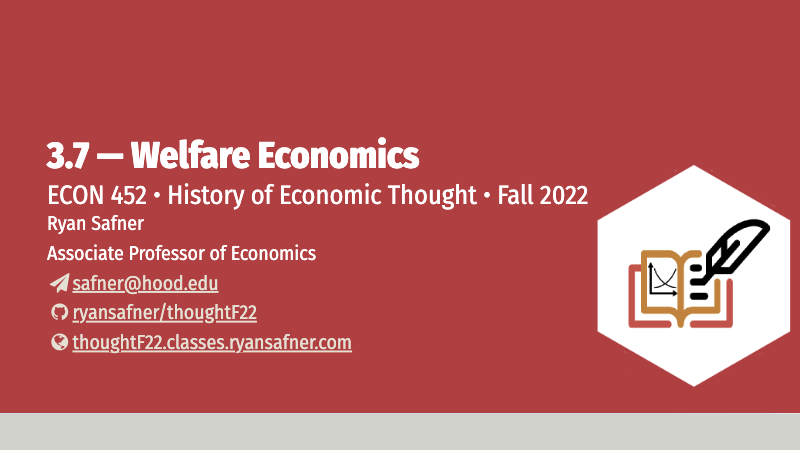3.7 — Welfare Economics — Class Content
Overview
Today we wrap up Neoclassical economics with a discussion of welfare economics, both in the British Marshallian tradition and in the Italian Walrasian tradition.
Readings
Required Readings
- End of Ch.11 “Walras and General Equilibrium Theory” (on Pareto) in Landreth & Colander
- Ch.13 “General Equilibrium and Welfare Economics” in Blaug
Recommended Readings:
- Blaug, 1996, “The Marginal Conditions” excerpt pp.577-579
- Humphrey, 1996, “The Early History of the Box Diagram”
- Persky, 2002, “Retrospectives: Pareto’s Law”
- Colander, 2007, “Retrospectives: Edgeworth’s Hedonimeter and the Quest to Measure Utility”
- Gabaix, 2016, “Power Laws in Economics”
The following Wikipedia entries can also provide more background:
Questions to Help Your Reading
What are indifference curves?
What is the contract curve?
What does a “determinate” vs. an “indeterminate” outcome of exchange mean?
Explain the Edgeworth box.
What is a Pareto improvement? What does Pareto optimal mean?
What are the two fundamental theorems of welfare economics?
What are the marginal conditions at an optimum? ## Slides
Below, you can find the slides in two formats. Clicking the image will bring you to the html version of the slides in a new tab. The lower button will allow you to download a PDF version of the slides.
You can type h to see a special list of viewing options, and type o for an outline view of all the slides.
I suggest printing the slides beforehand and using them to take additional notes in class (not everything is in the slides)!
Assignments
Participation/Discussion Board Posts Due 8 PM Fri Nov 4
This week’s graded discussion is worth 5 points, and can be a combination of discussion in class, and/or posts on the Blackboard Discussion Board by 8 PM this Friday November 4.
Tournament Votes
The first round of the Classical division of the “Most Interesting Economist in History” tournament is live. Please post your votes in the discussion board.
